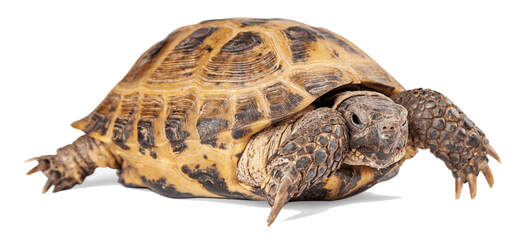Central Asian Tortoise

Common Name: Central Asian Tortoise
Scientific Name: Testudo horsfieldii
Physical Description: The Central Asian Tortoise has a high domed shell with yellow scutes, or scales, which shed off as the tortoise grows. These scutes are dark brown with yellow borders, like the scales on their legs. They have 13 scutes, typical of most species of tortoises and turtles. The Central Asian Tortoise has 4 toes with claws used for digging burrows to live in.
Habitat: The Central Asian Tortoise lives in dry, rocky, and grass filled lands at various elevations1.
Range: They live in the Central Asian Steppes including but not limited to Afghanistan, Armenia, the Russian Federation, Uzbekistan, and Azerbaijan.
Diet: They are herbivores that eat assorted vegetables and grasses.
Life Span: They can live over 50 years2.
Social Structure: The Central Asian Tortoise is a solitary animal aside from coming together to reproduce.
Status: Vulnerable3
Other: The Central Asian Tortoise undergoes brumation and can enter a state called torpor during cold weather. Brumation is not a true hibernation, instead a cold-blooded organism, or an ectotherm/poikilotherm, will slow its metabolic rate, and may not move, eat, or drink for extended periods of time. Torpor is a state entered for only short periods of time in which the metabolic rate is slowed to the extremes so that an organism can survive the most extreme cold conditions in a day.
[1] https://zoo.gda.pl/en/animals/central-asian-tortoise/
[2] https://www.norcalherp.com/uploads/8/0/8/3/80835988/online_version_outdoorrussiantortoise_4.pdf
[3] https://www.iucnredlist.org/species/21651/9306759
Scientific Name: Testudo horsfieldii
Physical Description: The Central Asian Tortoise has a high domed shell with yellow scutes, or scales, which shed off as the tortoise grows. These scutes are dark brown with yellow borders, like the scales on their legs. They have 13 scutes, typical of most species of tortoises and turtles. The Central Asian Tortoise has 4 toes with claws used for digging burrows to live in.
Habitat: The Central Asian Tortoise lives in dry, rocky, and grass filled lands at various elevations1.
Range: They live in the Central Asian Steppes including but not limited to Afghanistan, Armenia, the Russian Federation, Uzbekistan, and Azerbaijan.
Diet: They are herbivores that eat assorted vegetables and grasses.
Life Span: They can live over 50 years2.
Social Structure: The Central Asian Tortoise is a solitary animal aside from coming together to reproduce.
Status: Vulnerable3
Other: The Central Asian Tortoise undergoes brumation and can enter a state called torpor during cold weather. Brumation is not a true hibernation, instead a cold-blooded organism, or an ectotherm/poikilotherm, will slow its metabolic rate, and may not move, eat, or drink for extended periods of time. Torpor is a state entered for only short periods of time in which the metabolic rate is slowed to the extremes so that an organism can survive the most extreme cold conditions in a day.
[1] https://zoo.gda.pl/en/animals/central-asian-tortoise/
[2] https://www.norcalherp.com/uploads/8/0/8/3/80835988/online_version_outdoorrussiantortoise_4.pdf
[3] https://www.iucnredlist.org/species/21651/9306759






